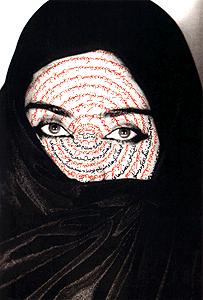 SHIRIN NESHAT
SHIRIN NESHAT
March 31 - June 4, 2000
In the late 1990s, Shirin Neshat began to concern herself with the medium of video. In doing so, she makes reference to both Western and Islamic film-makers, thus instigating a dialogue of cultures. What is of particular interest to her about post-revolutionary Iranian cinema is its specific imagery and language; a language that does not cross borders, but directly addresses them, thus highlighting details of a culture which otherwise would have been difficult to discover. Neshat says about these films that their "approach is simple, concise, poetic, minimalist and powerful as it criticizes society without claiming to do so." The exhibition gives a survey of the work of this artist, born in 1957, who recently received an International Award at the 48th Venice Biennale. The Kunsthalle Wien shows as a premiere the trilogy begun with the films Turbulent (1998) and Rapture (1999), concluding with the third part Fervor (2000) of which Shirin Neshat recently finished shooting in Morocco. The video installations all focus on the polarity and the dynamic between the male and the female gender in a world full of rules and taboos. Shirin Neshat creates with this double projections a dualistic space which makes it hard for the viewer to stay neutral. In Turbulent, Neshat juxtaposes a man's enraptured singing and the passionate appearance made by a woman. He, in a white shirt and black trousers, performs before an audience in similar attire. She, almost completely veiled in black, is presented by herself - nearly isolated. Whereas his singing also has words - it is the modernized version of a thirteenth-century Sufi poem praising divine love - she rather demonstrates the universality of music: without words, her appearance is difficult to relate to a specific tradition or time. Moreover, her entranced voice and gestures also transcend clear-cut distinctions of East and West. Rapture, shows men and women acting in sometimes ritualistic situations; the former immured in a fortress, the latter exposed on inhospitable open field. When the women in the end reach the sea, setting out in a boat for new shores, the uncertainty inherent in their rebellion indicates courage for change and criticism of the existing system, but also the possibility of failure, of going under at sea. It raises the alternative question of staying, so as to make leaving and emigration not the only way out. Fervor addresses the subject of tabooed sexual desire. A man and a woman meet in a lonely landscape where their paths incidentally cross. Later, the two happen to see each other again, yet in a totally different place. A bearded charismatic man standing on a platform and addressing the audience, preaching on the evils of 'sinful desire'. The tragic ending of the story, somberly admonishing every man and woman to learn their moral lesson from this and to resist such evil forces. The man and woman's initial excitement and modest flirtation turn into a deep sense of anxiety, confusion and guilt. An exhibition organised as a partnership between the Kunsthalle Wien and the Serpentine Gallery, London; it will be on show there from July 28 to Sept. 3, 2000. Catalogue: Shirin Neshat, 96 p., German/English, ATS 240,- (Euro 17,45) with texts by Hamid Naficy and Ruth Noack and an interview with Shirin Neshat conducted by Gerald Matt. |